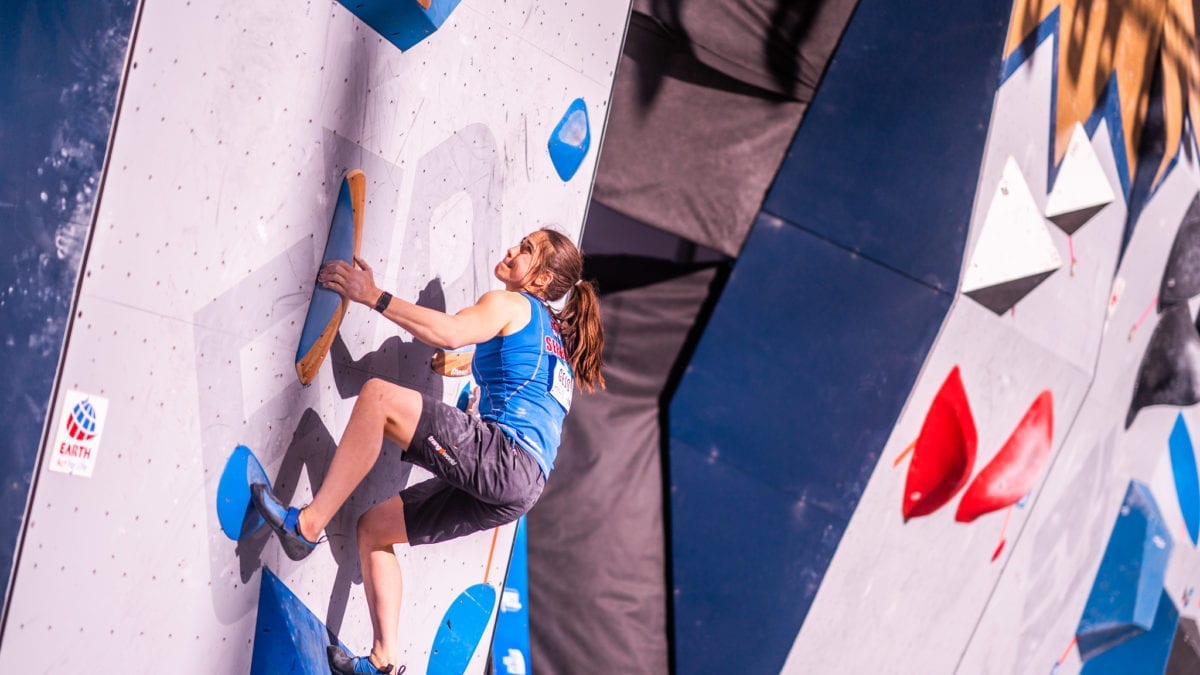An Unprecedented Finals Ends in Innsbruck
Among injuries, rainstorms, buzzer-beaters and last goes, Innsbruck's Bouldering World Cup comes to a close
 Photo by: Daniel Gajda of Stasa Gejo
Photo by: Daniel Gajda of Stasa Gejo
This evening saw the end of the most unpredictable Bouldering World Cup of 2021. Amid thunderstorms, cancelled problems, and buzzer-beating ascents, the athletes at Innsbruck showed spectators why competition bouldering remains climbing’s most exciting discipline.
Although the event began in relatively dry conditions, the weather became increasingly poor throughout the Women’s Final. Adding to the disarray, the Final round of competition came after third place qualified finalist Miho Nonaka injured herself during the Semis. As a result of her injury, she had to pull out of the competition, reducing the number of women in Finals from six to five.
In addition, the Women’s Finals carried the weight of an inappropriate approach to filming Johanna Farber in the Semi-Final round. This example represents one of the many times women have been sexualised in sport. As a result, the bouldering Semi-Final has been removed from YouTube. Hopefully, Farber will receive something in the way of reparations. In the meanwhile, male climbers might consider how they can better support their female counterparts.
This cloud overshadowed some excitement entering into Finals. With that said, athletes and commentators alike paid respect to Team Japan’s Akiyo Noguchi in her career’s final Bouldering World Cup. The seasoned competitor decided to retire following the Olympic Games, and appears on form for Tokyo’s long-awaited event. Although she didn’t podium in Boulder, she took Bronze in Lead yesterday.
Finals themselves progressed through a powerful W1. Only Japan’s Futaba Ito, America’s Natalia Grossman, and Slovenia’s Janja Garnbret would ultimately climb the problem. While both Grossman and Garnbret flashed, Grossman went feet first through this boulder that Garnbret campused.
W2 offered a unique challenge and became the most climbed of the three boulders. The problem featured a classic competition-style pogo into a catch, although many of the competitors climbed the boulder in unique ways. Ultimately, Grossman would take far too many attempts to secure first position. Grossman sent with a complicated walk, while Garnbret moon-kicked the entire length of the boulder. Her foot beta included a technical right foot skip from volume to volume.
Although the round had already featured some challenging moves, W3 offered a slower slab that required athletes to move quickly before slowing down at the top. Serbia’s Stasa Gejo climbed on it first. Although she climbed well, she could not make the top. Still, she secured the zone just as she had on W1. In addition to her top of W2 this final zone secured her Bronze Medal.
While Ito and Noguchi had trouble on W3, Garnbret flashed and Grossman sent with relative ease. Unfortunately, the round would end here.
While Gejo and Noguchi were afforded the opportunity to climb on W4, the storm had begun to reach dangerous levels of thunder and lightning. The beautifully set, three-dimensional W4 saw both Noguchi and Gejo achieve zone, but these results became lost on account of the weather in Innsbruck.
After the removal of W4, it became unclear whether the Men’s Final would run.
Spectators waited an hour and were rewarded with three challenging boulder problems. Although the first problem, M1, appeared to simulate Off the Wagon, the only ascent of the climb broke the famous campus-rose move and replaced it with body tension and a couple of thin matches.
While it appeared that America’s Nathaniel Coleman and Japan’s Tomoa Narasaki might have done the boulder if given a little more time, only Japan’s Yoshiyuki Ogata could complete the problem.
M2 began with a tense three-and-a-half minutes from Belgium’s Simon Lorenzi. The beautiful boulder featured numerous close calls, but it appeared unlikely that he would send. In the last 15 seconds, he managed to latch the screw-on left hand and jumped his way to the top with only a couple of seconds left on the clock. The crowd of athlete-spectators’ screams echoed throughout Innsbruck.
The dynamic problem saw a total of four ascents. Only Coleman and Japan’s Kokoro Fujii could not make the problem.
After an extremely dynamic set of boulders, the final boulder came as a surprise. M3 offered three similarly shaped, differently angled volumes that slowed the powerful round. Athlete after athlete faced the problem.
Lorenzi, Coleman and Austria’s Nicolai Uznik had middling success on the balance-based boulder. Ogata became the first athlete to make real progress and came close to latching the zone. Unable to stop his momentum, Ogata left the door open for Olympian Tomoa Narasaki to reach the top.
Pressing fingers in screw holes, Naraski traversed right and ultimately stuck the zone with a reverse wrap. His fingers literally latched the dual tex as his palm and thumb held the screw-ons. Gearing up for the final throw, it appeared Narasaki felt the nerves and, in the end, could not secure the finish. He would have won if he had sent.
This result cemented Ogata’s first place position as well as Narasaki’s Silver Medal. Third place remained up for grabs. In a phenomenal example of mental strength, the always joyful Kokoro Fujii took to the slab with confidence, taking two attempts to climb the unclimbed M3. Fujii would tie Uznik for tops and attempts. He would take third based on count-backs from the previous round.
The next World Cup will take place in Villars Switzerland and will feature both Lead and Speed. It begins with Speed Thurs. July 1.


